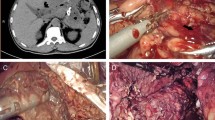Abstract
Background
The timely diagnosis of perforations or dead gut can be extremely difficult in micropremmies with necrotizing enterocolitis. A negative laparotomy is just as detrimental as failure to recognize early perforation in this group of patients. We have been exploring the role of microlaparoscopy using a needlescope to determine if this modality is feasible and useful in the surgical management of these patients. We report our technique and initial experience with needlescopic diagnosis.
Methods
Four patients (weight >500 to <1000 g) with abdominal distension and clinical sepsis not responsive to aggressive medical treatment were included in this study. None had radiologic evidence of pneumatosis or perforation. There was no absolute surgical indication for laparotomy except for strong suspicion of a surgical cause. Needlescopic diagnosis was performed in all these patients.
Results
There was no evidence of perforation or bile in the abdominal cavity in one patient. This patient improved on medical management, avoiding a laparotomy. The rest had bile or fibrin in the abdominal fluid with a localized perforation, and in each case we performed a microlaparotomy directly over the site of perforation to create a stoma.
Conclusions
Needlescopic diagnosis is feasible and appears to be safe, even in critically ill micropremmies less than 1000 g. The technique can provide useful information for surgical decision-making and allows for precise placement of a microlaparotomy incision over the site of perforation, thus minimizing the trauma from open surgery in this special group of patients. We are currently expanding its role in patients with overt perforations to determine if we can limit the extent of surgical exploration without compromising the adequacy of surgical management.




Similar content being viewed by others
References
Beasley SW, Auldist AW, Ramanujan TM, Campbell NT (1986) The surgical management of neonatal necrotizing enterocolitis 1975–1984. Pediatr Surg Intl 1: 210–217
Chwals WJ, Blakely ML, Cheng A, Neville HL, Jaksic T, Cox CS Jr, Lally KP (2001) Surgery-associated complications in necrotizing enterocolitis: a multiinstitutional study. J Pediatr Surg 36: 1722-1724
Ladd AP, Rescorla FJ, West KW, Scherer LR 3rd, Enqum SA, Grosfeld JL (1998) Long term follow up after bowel resection for necrotizing enterocolitis: factors affecting outcome. J Pediatr Surg 33: 967-972
Pierro A, Hall N, Ade-Ajayi A, Curry J, Kiely EM (2004) Laparoscopy assists surgical decision making in infants with necrotizing enterocolitis. J Pediatr Surg 39: 902-906
Rowe M, Reblock KK, Kurkchubasche AG, Healey PJ (1994) Necrotizing enterocolitis in the extremely low birth weight infant. J Pediatr Surg 29: 987-991
Author information
Authors and Affiliations
Corresponding author
Rights and permissions
About this article
Cite this article
Tan, H.L., Tantoco, J.G. & Ee, M.Z. The role of diagnostic laparoscopy in micropremmies with suspected necrotizing enterocolitis. Surg Endosc 21, 485–487 (2007). https://doi.org/10.1007/s00464-006-9030-x
Received:
Revised:
Accepted:
Published:
Issue Date:
DOI: https://doi.org/10.1007/s00464-006-9030-x




